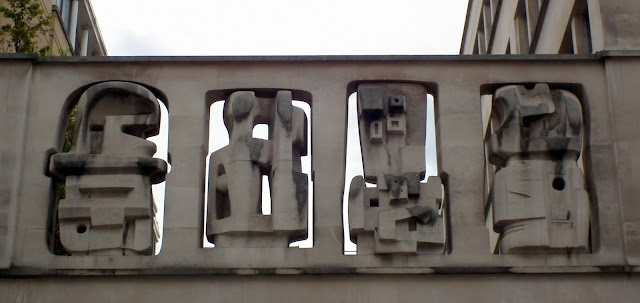Henry Moore didn't like doing architectural sculpture, largely because the sculptor is under the control of the architect and, even worse, the client. His first experience was at the London Underground building, which he hated even though the architect and client were the most artist-friendly team in history - Charles Holden and Frank Pick.
In 1951 he had become interested in the possibilities of sculpture as part of the architecture, however, so he welcomed the approach from architect Michael Rosenauer to work on the new Time-Life building. The fact that it was the richest commission in post-war London, funded in US dollars and therefore exempt from rationing on building materials, must have helped.
 In a lecture for the British Council in 1955, Moore recalled: "It was feeling that the time is coming for architects
and sculptors to work together again.....It seemed to me
that the screen must be made to look as though it was part of the
architecture, for it is a continuation of the surface of the building –
and is an obvious part of the building.....The fact that it is only a
screen, a kind of balustrade to the Terrace with space behind it, led me
to carve it with a back as well as a front, and to pierce it, which
gives an interesting penetration of light, and also from Bond Street
makes it obvious that it is a screen and not a solid part of the
building."
In a lecture for the British Council in 1955, Moore recalled: "It was feeling that the time is coming for architects
and sculptors to work together again.....It seemed to me
that the screen must be made to look as though it was part of the
architecture, for it is a continuation of the surface of the building –
and is an obvious part of the building.....The fact that it is only a
screen, a kind of balustrade to the Terrace with space behind it, led me
to carve it with a back as well as a front, and to pierce it, which
gives an interesting penetration of light, and also from Bond Street
makes it obvious that it is a screen and not a solid part of the
building."Moore characteristically rejects any form of surface relief because it would be "using the position only as a hoarding for sticking on a stone poster."
He also wanted to mount the sculptures on rotating mounts, so they could be turned round regularly for a variety of artistic effects, complaining bitterly that his proposal was rejected. "I’m sure that the people who built Chartres Cathedral were able to have second thoughts," he said.
A transcript of the lecture is here.
Moore did four maquettes of the screen, which he had cast in bronze in editions of ten for sale. It is interesting to see his design evolve - an example of the first version is in the Nasher Sculpture Center in Dallas, Texas, and I recently discovered a Maquette No 4 in the unlikely surroundings of a lobby in the Blue Fin Building in Southwark.



1 comment:
How super that you found the first version which, of all places on earth, turned up in the Nasher Sculpture Center in Dallas.
There is something rather wonderful about casting public sculpture in bronze. What was the theme of the four elements in the screen?
Post a Comment